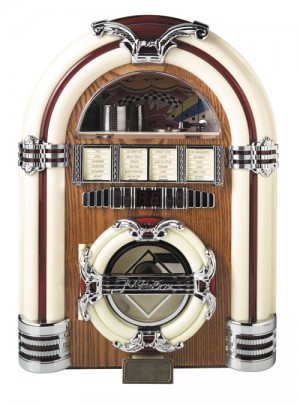This column first appeared in July 2012.
“Sunday, Monday, happy days. Tuesday Wednesday, happy days. Thursday, Friday, happy days………groovin’ all week with you.” With these lyrics the hit sitcom Happy Days came bounding into our homes from 1974-1984 and as we watched the opening credits many of us saw a familiar site from our youth — a jukebox!
Deriving it’s name from the Gullah word “juke,” meaning something rowdy, wicked, or disorderly, the jukebox of the mid-20th century is a true American icon and a hot commodity in the field of collecting.
It is the misconception of many that the jukebox came into popularity in the 1950s with the advent of rock and roll music, when, in fact, the “pay to play” machines have been around since 1890.
The granddaddy of the jukebox, the one song “Coin-slot phonograph,” first appeared in 1889 using phonograph cylinders. In 1910 the gramophone replaced the cylinders, offering up to eight selections. The jukebox, as we know it, surfaced in the late 1930s filled with opera, classical and big band “swing music” and was so well received that from 1943-1947 three-fourths of all records (shellac 78 rpms) produced ended up in jukeboxes.
In 1941 Wurlitzer replaced the standard plain wooden box with a model the appropriately named “The Peacock.” With it’s beautiful light show, full color animation and marbleized plastic casing, it set the standard for jukebox production until 1943 when metal and plastic were needed for the war effort and all manufacturing ceased until 1946. When production resumed, a number of new companies set up production and for the next 20 years the jukebox once again became the central attraction at soda shops and diners across America.
In the early 1950s The Seeburg Corporation introduced the first jukebox to play all 45 rpm vinyl records. Their 1953 Seeburg M100C (the one featured in Happy Days) accommodated 50 records offering the listener 100 selections. This very colorful model featured chrome accents, mirrors and rotating animation in the pilasters. They are currently bringing $3,000-$3,500 at auction.
Wall boxes were an important, and profitable, part of the jukebox. One of the earliest of these remote-play set ups came from the Seeburg Corporation. Their model 3W1 was introduced as a companion to the 100-selection Model M100A jukebox and both are highly collectible. Stereo sound became popular in the early 1960s after which wall boxes were designed with built-in speakers.
Names to watch for include the afore mentioned Seeburg Corporation, Wurlitzer, Rock-Ola, Gables Kuro, Link and Crosley. While an amazing number of the pre-1965 jukeboxes have survived, most of them will need to be restored or refurbished. No matter how good the deal, always get an estimate before buying a jukebox that is not working. Restoration requires a specialist and it can be pricey!
In November of 1988 on the occasion of the centennial of the jukebox, President Ronald Reagan released the following statement: “For a century now, the jukebox has been a fixture of popular culture in our land. In restaurants, diners, and clubs across our country, jukeboxes have long provided patrons with music for dining and dancing. The jukebox is to many a symbol of good, clean fun . . . and a treasury of memories for listeners of every generation. We celebrate it’s enduring place in American life. “ Well said Ron! Until next time . . . Linda
Linda Kennett may be reached at 317-258-7835 or lkennett@indy.rr.com



